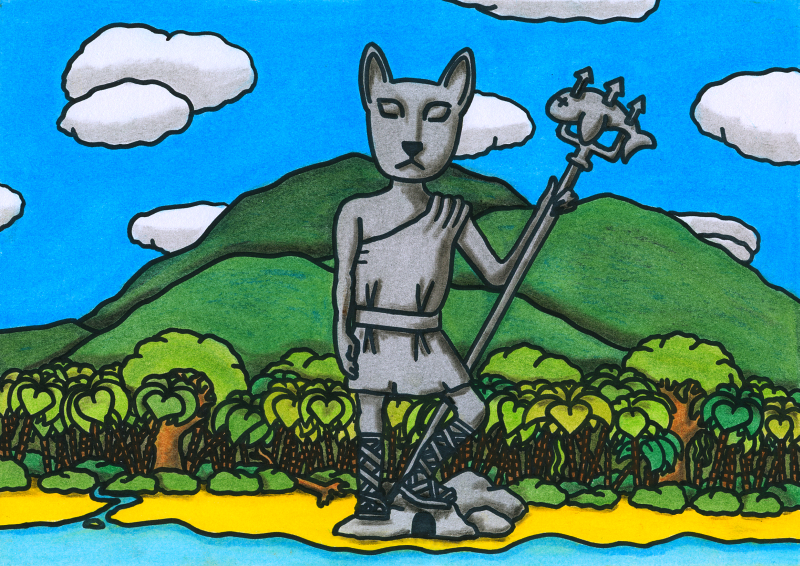
No-one is entirely certain where the statue of the great catanthrope that stands on a lonely island a few miles off the southern shores of Katsouli came from. The historian R.L. Smith once did a comprehensive study of all ancient sources relating to the catanthropes of the Gatoulian Sea, but found no mentions of its origin. Its existence even in the far past is attested to, but its builders remain completely mysterious.
Naturally, a wide variety of theories has been put forth:
- The statue is a present left behind by a people who sailed to Katsouli intent on conquest, only to encounter the most beautiful, graceful and powerful creatures in existence. (This theory is generally discounted, because then it would be the statue of an actual cat.)
- The statue is the work of a civilization endemic to the small island, which declined after its reserves of rock had been used up. (Most historians consider this theory to be silly, but a small minority of petrophiliac amateur historians refuse to stop going on about it.)
- The island was once visited by aliens with nothing better to do than build statues. (This theory is not entirely unlikely, but the lack of crop circles or alien droppings means there is a distinct lack of evidence.)
- The statue was one of many once built by a hypothetical civilization that arose in Katsouli in prehistoric times. (Some attribute the Sphinx to the same civilization, though living sphinxes take exception to that.)
- The statue is a representation of an ancient catanthropic god of hunting and fishing whose history has been forgotten. (Many theologians argue that this cannot be, as cats would never acknowledge that any of their deities are better at hunting than they themselves are.)
- The statue is the result of a cat dreaming after having been exposed to some peculiar work of popular culture. The Lands of Dream often grow in such ways, and it is possible that the statue grew backward into time, thus having no builders. (This is the most widely accepted theory.)
Reports by travellers only serve to confuse the matter further. An anonymous sailor from 12th-century Byzantium, passing through the region by accident, entered the small room at its base and reported that it was empty save for the writing on the walls, which he could not identify. Baruch de Spinoza, who spent several years living in Katsouli, claims the room contains stairs that lead down into some kind of labyrinth of mirrors; he does not state whether the labyrinth leads somewhere, but he does state that the air within smells of roasted fish.
Perhaps the most perplexing account stems from Hypatia of Alexandria, generally a highly reliable source, who is absolutely certain that the statue held its trident in the other hand when she saw it. This may or may not be related to St. Bede’s claim that when he visited the island, there simply was no statue. (Bede is not quite as reliable a source, to put it mildly. It’s entirely possible he was on the wrong island.)
As for the compiler of the Compendium, he is not certain which theory is correct or which stories are true. He is also far from certain that the citizens of Katsouli truly do not know the origin of the statue. There is no evidence to back up this suspicion, but look at their eyes. They know a lot more than they’re telling. And if one thing is certain, it is that never – not once in all its long history – has Katsouli been attacked from the south.
—
This entry in the Oneiropolis Compendium was made possible by Michael Brough.
